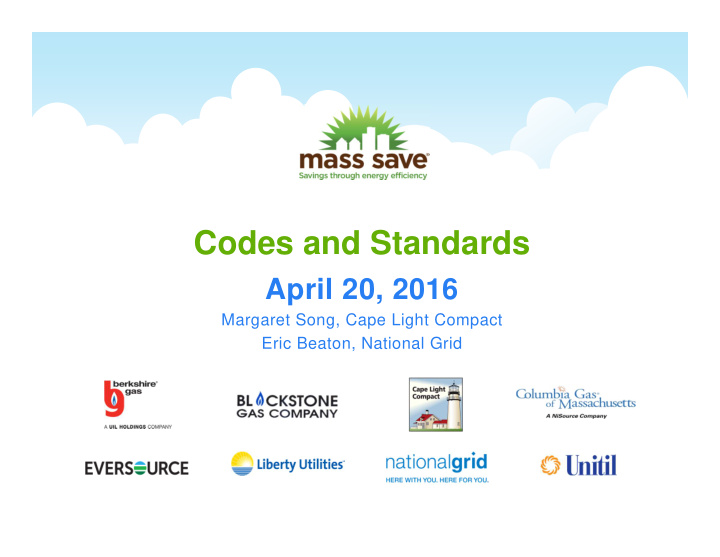



Codes and Standards April 20, 2016 Margaret Song, Cape Light Compact Eric Beaton, National Grid
Objective Question: What process does an innovative idea go through to become an approved measure with savings? Answer: The real world example of Codes & Standards
What Could be a Part of Codes and Standards? Compliance support: Base and Stretch code Appliance standards Support Stretch code ‘Design” support MA chose one to start.
History of Codes and Standards in Massachusetts 2009 2009 2011-2012 2011-2012 2013 - 2015 2013 - 2015 2010 2010 •PA planning with • NMR study finds • Residential •CSG (now stakeholders CLEAResult) – that codes and electric trainings •Heshong Mahone standards metric to Group (now part of •Savings for 2016-2018 savings could build off of TRC Solutions) with DOER and be 21-31% of 2008 GCA Consultants •Language in 2013- 2015 plan planned statute budgets for 4 requirement measures within the initiative! Evaluations throughout the entire process
The Importance of Energy Codes According to the U.S. Dept. of Energy: Energy codes are saving more than 40%-45% compared to the codes of a decade ago
California Started Codes and Standards efforts in the 1990s 2006 – 2008: The electric savings from C&S programs in California represent 60% of all savings from investor-owned utility programs At the time, CA was the only one to take credit. Today, CA estimates that ½ of their portfolio electric savings will come from codes and standards efforts.
Other States RI and many more started to join…
The Problem and How to Address It Problem: Less than 100% compliance with the base energy code Forward Path: Educate and provide resources so that the energy code is known and understood
Why are the PAs Involved? Code training mandated by 2008 Green Communities Act DOER provided training on 2009 IECC and stretch code from 2009-2012 PAs took over training on the 2012 IECC in 2014 New strategy for future portfolio savings PAs are the enablers and NOT the enforcers
Code Compliance Rates Residential compliance 63% at beginning of 2009 IECC cycle; 76% compliance at the end of the 2006 IECC cycle. (Both used PNNL method) 2012 study / Commercial compliance 80% using mixture of 2006 IECC and 2009 IECC permitted buildings 2014 study / Commercial compliance 82% for 2006 IECC; 76% for beginning of 2009 IECC; 85% at the end of 2009 IECC (all used PNNL method)
Code Compliance Rates 2014 study also used an alternative approach called “Massachusetts Commercial and Industrial Evaluation Contract Methodology” (MA-CIEC) - Awards partial credit for partial compliance with code requirements 2014 study / Commercial compliance using MA-CIEC was 93% at the end of the 2009 IECC
Code Compliance Support Initiative (CCSI) in MA RFP Issued in late 2013 RFP Awarded to Conservation Services Group (now CLEAResult) CCSI Begins: April 1, 2014 First official classroom training occurred September 23, 2014 CCSI initial contract ends: December 31, 2016
Classroom Training & Webinars
CCSI Participation (April 2014-February 2016) 42 residential classroom trainings 21 commercial classroom trainings 18 residential webinar hours 1,574 attendees trained at residential classroom sessions 655 attendees trained at commercial classroom sessions 483 attendees trained at residential webinars Total participants: 2,712
Classroom Training Attendance Breakdown (April 2014-February 2016)
Statewide Circuit Riders
Statewide Documentation Tools
MA Energy Codes 2012 IECC with MA amendments effective July 1, 2014 Next code version is 2015 IECC for possible MA adoption as early as July 1, 2016; concurrency period through December 31, 2016. Existing stretch code effective with 2009 IECC - Expected new stretch code to coincide with 2015 IECC The CCSI will need to adjust to new energy code trends such as increased building testing, renewables and outcome-based codes
Questions? To learn more, contact: Eric Beaton Margaret Song 781-907-3780 508-375-6843 Eric.beaton@nationalgrid.com Msong@capelightcompact.org www.masssave.com/energycode
Thank You
Recommend
More recommend